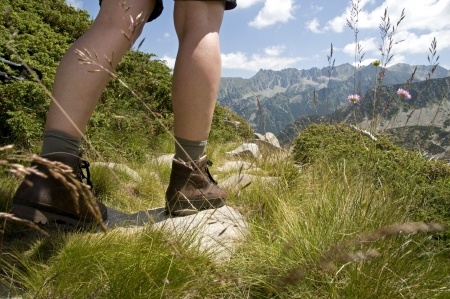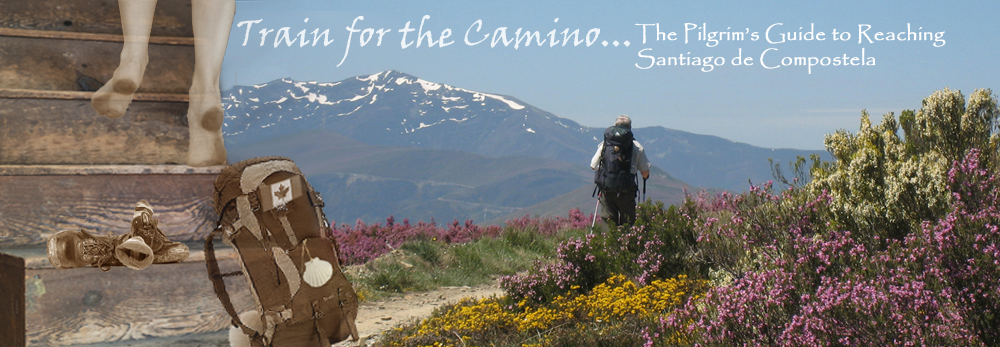 I recently had a comment submitted asking questions about blisters and shoes for walking the Camino de Santiago. And so Vicky, in answering your questions, I decided to include my guidelines for evaluating, planning for and maintaining foot health in the following 4 tips:
I recently had a comment submitted asking questions about blisters and shoes for walking the Camino de Santiago. And so Vicky, in answering your questions, I decided to include my guidelines for evaluating, planning for and maintaining foot health in the following 4 tips:
1) Try on and evaluate many boots and buy the best, well-fitted lightweight, waterproof hiking boot/shoe with good ankle support for your foot type. Combine with self-wicking, fast-drying hiking socks. Evaluate socks before you buy your shoes and bring your first choice of socks when you are getting fitted for your boots. When you are buying your boots, ensure your sales help has experience with long distance hiking, and walking in many different terrains. Ask if they have a ramp for testing the uphill, downhill fit / feel of the boot.
2) Always simulate the walking conditions you will encounter on the Camino, wear the same type of socks, carry the same weight, and put at least 70-80 kilometers of wear and tear on your boots before making a final decision. Develop a training plan. Start off slowly and gradually increase and record your distance, weight carried, terrains covered, and comments on foot health, walking experience and results. (See my previous blog on training planning.)
- Walk in the rain. Decide on your rain gear, purchase and walk with it on as part of your evaluation. How your boots perform in the rain is critical.
- Walk on uneven and varied terrains, cobblestone, pavement, uphill, downhill. Walk the daily average distance (in my case 20 km) several times including the various terrain conditions.
- Walk enough and do exercises to build up ankle, and foot strength.
- Develop a foot care kit and routine. (Keep toe nails clipped, feet clean, salved and massaged. Include daily scrutiny and blister prevention care.)
- Walk with the weight you will carry on the Camino, building up gradually, as part of your training plan.
- Purchase your walking stick and practice with it on various terrains
3) If you get blisters, foot or related leg pain (eg. shin splints) evaluate the cause. Over the years I have experienced each one of the scenarios below. I usually bring the shoes back to where I bought them and ask for advice and possibly a shoe return or swap.
- Are your shoes too loose, causing your foot to move around and the rubbing results in blisters?
- Are your shoes too tight and your toes or heels are pressing into the shoe, causing blisters and lost toenails? Is a heavy sock causing the tightness?
- Is your sock fit too loose resulting in the sock bunching up and causing blisters?
- Is the shoe too rigid, even after wearing them in? Are rigid shoes causing lost toe nails and heel blisters?
- Do both your shoes and socks get soaked in the rain, stretch, bunch, and cause blisters?
- Did you walk too far, too early before the boots were broken in, and is this the cause of the blisters?
- Is it just a badly fitted, constructed shoe, and not suitable for long distance hiking, and walking? Listen to your feet and related walking muscles.
4) If you have walked 80 plus kilometers in your new boots, (in most of the conditions listed above), and have no blisters, foot or related leg pain, you are finished.
Are you thinking there are too many dimensions to foot health; that this will take too much time, effort, and money? A bad hiking boot and poor foot health can ruin the enjoyment and even risk your ability to complete walking the Camino. Badly constructed or ill-fitting boots can also strain or injure other walking muscles. Maintaining overall foot health should be a top priority.
I will post my boot / sock evaluation results when I have completed my testing. This will not be for several months. Hope this helps Vicki. I will answer your additional questions next post.
In the meantime I welcome other comments and questions. Please feel free to leave a link back to your own blog too if you have one, via the commentluv feature here on the site.
Buen Camino
Marion

a few tips I read recently…Shop for new shoes in the afternoon, when your feet have expanded to their maximum size.
Peppermint oil or even peppermint tea is an excellent ‘soak’ for tired feet.
Wrap a thick rubber band around all of your toes on one foot. Spread your toes and hold the stretch for five seconds. Good to relieve ‘shoe or boot bound’ feet .
Finally, baking soda and cornstarch is a good thing for feet to relieve odor and absorbs moisture..Happy travels sister..